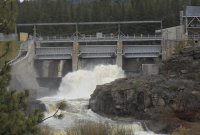Support strong Canadian climate journalism for 2025
A United Nations monitoring mission to a world heritage site in northern Alberta appears likely to focus more attention on the contested Site C hydroelectric project next door in British Columbia.
Wood Buffalo National Park, a UNESCO world heritage site since 1983, is under review this week at the request of the Mikisew Cree First Nation, which petitioned the world body in 2014 to list the park as being under threat from various developments.
The park is at the convergence of the Peace and Athabaska rivers and is considered the largest freshwater boreal delta on the planet.
Conservationists and local First Nations are concerned about how two existing hydro dams on the Peace River are affecting the hydrology of the park — a problem they say will be compounded by B.C.'s massive Site C dam that's going ahead on the Peace River.
"We're looking for them to list it as endangered so Canada can really take a more proactive means in managing those impacts and activities," Melody Lepine, the director of government and industry relations for the Mikisew First Nation, said Sunday in an interview after arriving with the review group in Fort Smith, N.W.T.
The World Heritage Centre concluded in 2015 that a review of cumulative effects on Wood Buffalo National Park was warranted, and in the meantime asked that Canada not make any other development decisions that "would be difficult to reverse."
Nonetheless, the Trudeau government issued federal fisheries permits this summer to allow construction to go ahead on Site C, which will dam an 83-kilometre long reservoir on the Peace River.
"They should have waited until they knew the outcome of the mission and the actual state of the Peace-Athabaska delta in terms of its ecological integrity and needs," said Lepine.
"So to approve another project that could have those irreversible impacts I think is deeply concerning. It's not fair to the community, it's not fair to the Mikisew, it's not fair to the heritage site that they're supposed to be managing."
The 10-day "reactive monitoring mission" of Wood Buffalo by two international UNESCO experts got underway Sunday, after being postponed earlier in the year due to the wildfires around Fort McMurray, Alta.
The park review opens a new front in the battle over Site C, which is already being challenged in Federal Court by two B.C. First Nations.
The federal permits quietly issued in late July further inflamed the debate, with Perry Bellgarde, the national chief of the Assembly of First Nations, publicly stating this month that the hydro project is not being handled in keeping with Canada's constitution nor with the UN Declaration on the Rights of Indigenous Peoples.
Those concerns about indigenous consultation dovetail with the complaints over the management of Wood Buffalo National Park.
The World Heritage Committee's decision to go ahead with the review noted "with concern the lack of engagement with indigenous communities in monitoring activities, as well as insufficient consideration of traditional ecological knowledge."
Federal Environment Minister Catherine McKenna welcomed the UNESCO monitoring mission, which could only come with the invitation of the federal government.
"The government of Canada is committed to preserving our national parks, some of which are recognized World Heritage sites, and doing so in partnership with local communities, Indigenous peoples and other stakeholders," McKenna said in a statement Friday.





Comments
The need for Site C is based upon potential future needs and today's technology. Look back 50 or 75 years to review current technological advancements. Recently a Vancouver High School student won 1st prize [$75,000] at an International High School Science fair in Arizona. His project demonstrated the use of water from processing sewage to generate electricity, sufficient for the need of a city. The building of Site C is based upon purported future needs and without considering new technology. This can lead to two errors: 1] the error of comission, doing something when it was not indicated; or, 2] the error of omission, not doing something when it was indicated. If the decision is NOT to build and it was learnt that it was needed, this omission error in delaying construction would likely result in increased cost. If the projected potential need for additional energy either did not materialize and/or was met through the use of other technology, then this error of comission resulted in the destruction of cultural and agricultural land, an error, which is of far greater significance than that of increased cost due to delayed construction.